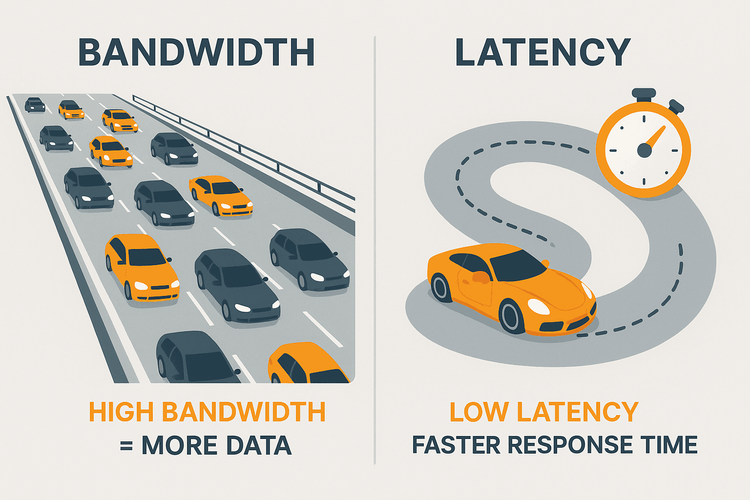You’ve just arrived in a new country, excited to explore. You connect your phone, see full 5G bars, and think you’re set. But when you try to video call home, the image freezes. You try to play your favorite online game, and your character is lagging all over the screen. You’re paying for high-speed data, so what’s the problem?
The hidden culprit is likely high latency, also known as ping. While download speed gets all the attention, latency is the unsung hero of a great internet experience, especially for travelers. Understanding it is key to staying smoothly connected. For a truly seamless connection on your next trip, explore Yoho Mobile’s flexible eSIM plans designed for performance.
Speed vs. Latency: What’s the Real Difference?
Many people use “fast internet” to describe both speed and responsiveness, but they are two different things. Think of it like a highway:
- Bandwidth (Speed): This is the width of the highway. A wider highway (higher bandwidth) can handle more cars (data) at once. This is measured in Megabits per second (Mbps) and is important for downloading large files or streaming 4K movies.
- Latency (Ping): This is the time it takes for one car (a packet of data) to travel from point A to point B and back. This is measured in milliseconds (ms). A lower number is better, indicating a more responsive connection.

Here’s a simple breakdown:
| Metric | Analogy | Measures… | Better is… |
|---|---|---|---|
| Bandwidth | Width of a highway | Data capacity | Higher |
| Latency (Ping) | Time for a round trip | Responsiveness / Delay | Lower |
You can have a massive 100 Mbps connection (a very wide highway), but if your ping is 300ms, every action you take online will have a noticeable delay. That’s why a simple internet speed test shows you both download/upload speeds and your ping.
Why Low Latency is Crucial for Modern Travelers
For travelers, a responsive connection is often more critical than raw download speed. Here’s why a low ping matters for your activities abroad.
For the Mobile Gamer Abroad
If you unwind by playing Call of Duty: Mobile or Genshin Impact after a day of sightseeing in Tokyo, latency is everything. High ping creates lag—the frustrating delay between you pressing a button and the action happening on screen. In competitive gaming, a ping over 100ms can be the difference between victory and defeat. This is why finding the best low latency eSIM for mobile gaming is a top priority for traveling gamers.
For the Digital Nomad & Remote Worker
Ever been on a Zoom call where you talk over someone because of the delay? That’s high latency at work. For digital nomads relying on real-time communication tools like Slack, Microsoft Teams, and video conferencing, low ping is non-negotiable. It ensures conversations flow naturally and collaborative tools update instantly, answering the painful question of “why is my internet slow for video calls abroad?”

For Casual Browsing and Streaming
Even for everyday tasks, latency makes a difference. When you click a link, your device sends a request to a server, which then sends the website data back. High latency means a longer wait for that initial response, making even fast-loading websites feel sluggish.
How eSIMs Can Help You Achieve Lower Latency
So, how can you ensure a low-ping connection while traveling? The answer lies in connecting to local networks, and a high-quality eSIM is the best way to do it.
When you use your home provider’s roaming, your data often takes a detour back to your home country’s servers before going to its destination. This massive physical distance dramatically increases ping.
An eSIM, like those from Yoho Mobile, connects you directly to a local carrier in the country you’re visiting. For instance, if you’re in Spain, you connect to a Spanish network. This significantly shortens the data’s travel distance, leading to a much lower and more stable ping.
Yoho Mobile enhances this benefit by partnering with premium, top-tier network providers in each country, ensuring you’re not just on a local network, but one of the best available. Find the perfect low-latency plan for your next destination.
Choosing the Best Low-Latency eSIM: Tips for Travelers
Not all eSIMs are created equal. Here’s how to pick one that prioritizes performance:
- Check Carrier Partnerships: Look for providers like Yoho Mobile that are transparent about their partnerships with major local networks, not just budget carriers.
- Test Before You Commit: Worried about performance at your destination? Yoho Mobile offers a game-changing free trial eSIM. You can activate it and test the network responsiveness before purchasing a larger plan. Try our free eSIM trial before your trip!
- Consider Your Destination: Network quality can vary. A plan for a trip to South Korea will likely have excellent latency. Planning a multi-country European tour? A regional eSIM that offers strong carriers in each country is ideal. For example, you can explore our Europe Travel eSIM Plans that cover all your needs.
- Stay Protected: Don’t let the fear of running out of data stop you. With Yoho Care, you’re protected from sudden disconnection even if your data runs out, giving you peace of mind to manually top-up when you’re ready. Learn more about Yoho Care.
Before purchasing, it’s always a good idea to ensure your device is compatible. You can check our extensive eSIM compatible device list to be sure.
Frequently Asked Questions (FAQ)
Q1: Can an eSIM have lower latency than a physical SIM?
An eSIM and a physical SIM are just different form factors for accessing a network. The key factor for latency is the network they connect to. A Yoho Mobile travel eSIM connecting to a premium local network in Japan will almost always have lower latency than a physical SIM from the US that is roaming in Japan.
Q2: How can I test my eSIM’s ping while traveling?
You can use popular internet speed test applications like Speedtest by Ookla or fast.com on your phone. These apps will measure your download speed, upload speed, and, most importantly, your ping in milliseconds (ms).
Q3: Will a 5G eSIM guarantee low latency?
While 5G technology is designed for lower latency than 4G/LTE, it’s not an automatic guarantee. The quality of the local network, congestion, and the distance to the server you’re accessing are still major factors. However, an eSIM connecting to a strong local 5G network provides the best possible conditions for low latency.
Q4: What is a good ping for mobile gaming abroad?
For a smooth, competitive experience, gamers should aim for a ping under 60ms. A ping between 60ms and 100ms is often playable but not ideal. Anything consistently over 150ms will likely result in noticeable lag and a frustrating experience.
Conclusion
In the world of travel connectivity, speed is only half the story. Latency is the critical, often-overlooked metric that determines how responsive and seamless your online experience feels. For video calls without awkward delays, online gaming without lag, and web browsing that feels instant, a low ping is essential.
By choosing a high-quality travel eSIM from Yoho Mobile, you bypass the high-latency pitfalls of traditional roaming and connect directly to the best local networks. This ensures you get the fast and responsive internet you need to work, play, and connect without frustration.
Don’t let lag ruin your travels. Choose a fast, responsive eSIM from Yoho Mobile today!
